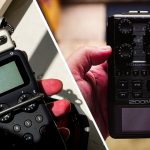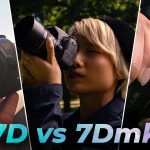In this review, we’re going to have a look at not only what the cameras can do, but all the other things that make this device the NEARLY perfect phone. And with that, let’s start by having a look at the size and build of the phone.

Size & Build
Upon first holding it, you will quickly notice that the phone is large and rather heavy. In fact, it’s slightly larger than its 12 Pro Max predecessor.
Measuring 6.3×3.1×0.3 inches, and weighing in at 8.5 ounces, or 241 grams, this phone is definitely quite beefy, at least by modern standards. In fact, when placed in the pocket of my shorts, it actually sticks out slightly.
Because of its size, this is definitely a two-handed device. If you like using your smartphone with one hand, you’re definitely going to have some difficulty with this one.
I personally simply accept the fact that if I want great battery, the phone just has to be larger, so therefore I use the phone with both hands by default. The expectation of phones being one-handed devices is gone, at least for me.
In terms of design, the 13 Pro Max retains the flat edges of the iPhone 12 Pro Max, thus having a similar overall feel.
In terms of colours, the 13 Pro Max comes in graphite, gold, silver and sierra blue. I personally love graphite, so I always stick with that. You could argue that the other colours are flashier, but ‘flash’ is not one of the factors I consider when making a purchase decision.
When looking at the bottom of the device, you’ll notice that Apple has opted to stick with its proprietary lightning port, instead of switching to USB-C. Many consider this to be a strange move, given that newer iPads and MacBooks all use USB-C.

Image Quality
When looking at the back of the device, the first thing you might notice is that the cameras are bigger, due to the larger sensors, compared to the iPhone 12 Pro Max.
The main wide camera is the largest one yet, increased by 12% in size from the previous 12 Pro Max camera. While boasting a f/1.5 aperture, the new lens is rated to deliver 49% more light than its predecessor, the wide lens on the iPhone 12 Pro Max.
The ultrawide camera also offers a larger aperture of f/1.8, from f/2.4 on the iPhone 12 Pro Max. The lower number represents an increase in aperture, and thus more light being allowed into the lens.
Zooming on the new iPhone gets a boost too, as the iPhone 13 Pro Max’s telephoto lens boasts a 3x optical zoom, a 20% increase from the previous model, which could only do 2.5x.
Here are some more photos I took with the iPhone 13 Pro Max.

Macro Photography
As opposed to a lot of other phones, the 13 Pro Max now allows you to do some proper macro photography. What happens is when you zoom in close enough, the phone switches to the ultra-wide lens automatically, and allows you to take photos really close-up.


By default it does so automatically. If you want to be able to manually decide when you want macro mode or not, you need to go into Settings, Camera, scroll all the way down, and enable Manual Macro mode.
This gives you a button which allows you to enable or disable it in the camera app. The reason why you’d want to manually control it is if you take a lot of close-up photos, but want to use the main wide lens, with the better sensor.
If you get too close, and the phone switches to macro mode, you will be able to get a lot closer, but you’ll be using the sensor behind the ultra-wide lens, which will produce lower quality photos.

Bokeh
When reviewing the cameras on a phone, I normally would not have a special section just for Bokeh, but I feel like I need to for this one.
The natural Bokeh that you get with the lenses is ok, as you can see above.
What I want to talk about is the fake Bokeh, or the Cinematic mode, as Apple calls it. The issue with fake Bokeh in general, is that it looks obviously fake to photographers and videographers.
It just cuts around the subject, and slaps a blur effect onto everything else. Things get even trickier when hair is involved, due to its granular nature.


I have to say though, that the fake Bokeh on the iPhone 13 Pro Max is at times quite impressive. In photos like these, if you zoom in on the hair, you can see where it comes a little bit short.
The way to access this is going into the camera app, and swiping left, until you’re on Cinematic mode, which is basically Portrait mode, but for video.
Unfortunately, the Cinematic mode resolution is capped at 1080p across the entire iPhone range, so you won’t be able to shoot 4K videos in Cinematic mode.
Video
Now that we’ve covered Cinematic mode, let’s jump into the actual video capabilities of this phone.
The iPhone 13 Pro Max shoots beautiful video, even just with default settings, in auto mode. I tried to mostly stay away from third party apps for this review, as it occurred to me that the point of using a smartphone for filming is convenience.
Yes, you can squeeze more image quality out of the phone if you manually adjust everything, assuming you know what you’re doing of course, but if you’re going to do all of that, you might as well just use your DSLR.
The point of the smartphone is that you can just take it out of your pocket, and start filming, or taking photos.
Unlike last year’s model, the iPhone now supports ProRes video. You can record in ProRes at up to 30 fps in 4K. It’s important to note that this is only available in the models with at least 256GB of storage. If you only have 128GB, you’ll be limited to 1080p ProRes.
This is likely due to the size of the ProRes files, which would require a lot more storage and bandwidth to work with.
I’m currently torn about the ProRes, because it genuinely looks better than just the regular video mode, but the issue is being capped at 30fps.
Since I shoot a lot of slow-motion B-roll, I prefer to have at least 60fps, if not 120fps available to me. The 30fps is rather limiting in that regard, but at the same time, the ProRes video just looks better.
It doesn’t have that over sharpened quality which a lot of smartphone footage has, which is why I’m drawn to it.

Accessories
When it comes to filmmaking accessories, the Beastgrip Cage I used for the iPhone 12 Pro Max would still work, as it’s a universal cage, and the 13 Pro Max is only marginally larger than the 12 Pro Max.
I’ve opted not to test out external lenses for the phone this time around, as I realised that using them removes the convenience of the phone, which is part of the appeal.
If I want to bother with swapping lenses, I’ll just bring my DSLR with me.
Display
The display, is as you would expect, absolutely gorgeous. They also have ProMotion now, which means that the refresh rate on the screen is automatically adjusted from 10Hz to 120Hz, depending on what you’re doing, and how much battery you have left.
In short, the more Hz, the smoother the scrolling and animations look. Will you necessarily notice this?
Chances are you won’t, but if you use a 120Hz device for a while, and then go back to an older phone with 60Hz, the difference will be immediately apparent.
When it comes to the notch, which is now 20% smaller, I thought it would bother me a lot more than it does. In fact, I resisted upgrading for years, specifically because of the notch. Once I got my hands on the iPhone 12 Pro Max last year though, I forgot the notch is even there.
It’s just not noticeable, as your brain tunes it out after a while. The same applies to the MacBook Pro M1 Max by the way. Before purchasing it, I thought the notch would bother me. In reality, I keep forgetting that it’s there.
As I’m writing this, I’m reminded that it’s there, and I can see it in the periphery of my vision, but once I’ll be done with writing, I’ll forget about it again.
By the way, if you want to see a review of the MacBook Pro M1 Max, especially in regards to video editing, make sure to subscribe, as I’ll review it soon.
Control
One of the features which is absent in the newer iPhone models, is Touch ID. Face ID is fine, but I’d love to see a Touch ID option, under the screen perhaps.
The same applies to the iPad Pro 12.9″ (4th Gen). The Face ID is a bit awkward if you’re holding the tablet, due to its size. I would have loved to see the power button double as Touch ID, like on the iPad Air 4th gen.


Storage
The storage options come in 128GB, 256GB, 512GB, and 1 TB. I personally have the 512GB model, as I know I’ll be using this phone quite a bit for photography and videography, but 1TB is a bit too much for me.
As mentioned above, if you buy the 128GB version, you won’t have access to some of the video capabilities of the phone, namely shooting 4K ProRes.
I also occasionally use it to listen to audiobooks. I have quite a few books on Audible, so what I’ve done is downloaded a lot of them, and I don’t even need to worry about the storage space.
By the way, if you’re looking to get into audiobooks, I really recommend Audible. I own over 200 audiobooks on there, and as you can see, I have quite a bit of listening time. A feature that I also really like is that I can go to the website, and I can download my own local copy of the audiobook. That way, you get to actually own what you buy.
The book that I’ve just finished listening to is ‘Ego is the Enemy’, by Ryan Holiday.
Feel free to check Audible out. This isn’t an ad by the way, just a service that I genuinely use a lot. (It is an affiliate link though)

Battery Life
So one of the first things that I noticed about this phone after using it for a while is the battery life. As a quick disclaimer, I try to not use my phone as much as possible.
I also have most notifications disabled, I have relatively few apps installed, and I went in and tinkered with them, only allowing some of them to do background stuff, where it made sense.
This is because I enjoy working with as few distractions as possible. I have the same approach on my MacBook as well, where I keep it very clean and minimalistic.
If you guys are interested, I might make a studio tour video, where I show you what equipment I use, and then I also do a deep dive on my computer, and show you which apps I use for productivity and work. If you want that, let me know in the comments.
So back to the phone. With my minimal use, battery can last 2-3 days easily. I’ve honestly stopped worrying about it, almost as if the phone doesn’t need a battery to function.
When I went out and did a shoot with Peony, I did bring a power bank just in case, but I didn’t actually have to use it.
We shot for about two hours, photos and videos, and I had more than enough juice left in the phone by the time I got back home.
I don’t even leave it to charge over night. My phone usually sits to my left on my desk, face down. When I notice the battery gets to around 30%, I just snap the MagSafe charger on, and the next thing I know, it’s at 100% charge.
I prefer MagSafe charging, now that I’ve tried it. It’s incredibly convenient, and given that I go to great lengths to touch my phone as little as possible, I do not mind that it charges more slowly.
Longevity
When it comes to longevity, the iPhone 13 Pro Max screen is protected by a tough Ceramic Shield. This supposedly makes it a lot more resistant to stretches and impacts. It also has IP68 water and dust resistance.
Do note that the screen can still accumulate light scratches over time, from the keys you carry in your pocket for example. I personally don’t mind that, as they’re not really visible, unless you really look for them.
When it comes to a case, I personally use the Apple Black Leather case, which is rather overpriced for what it is, but feels nice in the hand. I’m considering getting some protection for the actual lenses themselves, but I personally don’t like adding any protection on the screen itself, as to me, that ruins the feel of the phone.
That’s just me though. If you want to protect your investment, and also make sure you get more resell value when you eventually upgrade, getting as much protection for it as you can makes sense.
Cleanliness
One of the problems with these newer devices, is cleanliness. Given that they’re so slick and shiny, they’re fingerprint magnets.
To solve this, I’ve recently discovered WHOOSH!, which is apparently what Apple uses themselves in their stores. I have seen some debate on this online actually, so if you know for a fact one way or another, let us know in the comments.
So I bought the 8ml bottle, which has allowed me to clean my phone, iPad, and MacBook a few times over.
Next time, I’ll go for a larger bottle, as the stuff works quite well. If you want to check it out, I have an affiliate link down below for it, as well as links for everything else mentioned in this article.
Conclusion
So, in conclusion, should you buy the iPhone 13 Pro Max?
This device has great cameras, amazing battery, a beautiful display, and genuinely feels amazing to hold in your hands.
If you’re upgrading from an older iPhone, like a 6s Plus, or even an iPhone X, you’ll most likely be blown away by the improvement.
If, on the other hand, you have the iPhone 12 Pro Max, and you’re happy with it, upgrading to the 13 Pro Max will not be a massive step up, but a gradual improvement.
To be fair though, we’re at a point technologically, where leaps and bounds are rare. Every year, phones will be slightly better, but won’t blow the previous generation out of the water.
If you do have an older phone, and you’re not quite convinced by the iPhone 13 Pro Max, feel free to have a look at my iPhone 12 Pro Max review. The phone is a bit older by this point, so you’ll be able to get one second hand for a far more decent price.
There is also another point to consider. Given that the iPhone 14 Pro Max is due to come out later on this year, waiting might be worth it. After all, there are rumours floating about that the new 14 Pro Max will have a new design, and no notch.
According to MKBHD’s video, released a couple of days ago as I’m writing this, rumour has it that the 14 Pro Max will have a smaller notch, which looks like this, and it will apparently have a higher end 48MP main camera.
These are just rumours at this point obviously, and we won’t know for sure until Apple officially unveils the new phones later on this year. But, if you have a 12 Pro Max, it might just be worth waiting for the 14 Pro Max. If, on the other hand, you’re upgrading from a much older model, you’ll get a much better deal price-wise by looking at the 12 and 13 Pro Max instead.
If you’d like to purchase any of the items I’ve mentioned in this article, or see how much they cost in your country, I have a link down below where you can view them.
Thank you for reading my review of the iPhone 13 Pro Max. I invite you to have a look at some of my other articles. We have something for everyone, whether you’re interested in audio, or cameras and lenses. Alternatively, if you prefer video reviews, feel free to have a look at my YouTube channel.
Links
Here are all the products mentioned in this article, conveniently listed together.



